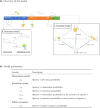Effects of resource availability and interspecific interactions on Arctic and red foxes' winter use of ungulate carrion in the Fennoscandian low-Arctic tundra
- PMID: 38571799
- PMCID: PMC10985358
- DOI: 10.1002/ece3.11150
Effects of resource availability and interspecific interactions on Arctic and red foxes' winter use of ungulate carrion in the Fennoscandian low-Arctic tundra
Abstract
In the Arctic tundra, predators face recurrent periods of food scarcity and often turn to ungulate carcasses as an alternative food source. As important and localized resource patches, carrion promotes co-occurrence of different individuals, and its use by predators is likely to be affected by interspecific competition. We studied how interspecific competition and resource availability impact winter use of carrion by Arctic and red foxes in low Arctic Fennoscandia. We predicted that the presence of red foxes limits Arctic foxes' use of carrion, and that competition depends on the availability of other resources. We monitored Arctic and red fox presence at supp lied carrion using camera traps. From 2006 to 2021, between 16 and 20 cameras were active for 2 months in late winter (288 camera-winters). Using a multi-species dynamic occupancy model at a week-to-week scale, we evaluated the use of carrion by foxes while accounting for the presence of competitors, rodent availability, and supplemental feeding provided to Arctic foxes. Competition affected carrion use by increasing both species' probability to leave occupied carcasses between consecutive weeks. This increase was similar for the two species, suggesting symmetrical avoidance. Increased rodent abundance was associated with a higher probability of colonizing carrion sites for both species. For Arctic foxes, however, this increase was only observed at carcasses unoccupied by red foxes, showing greater avoidance when alternative preys are available. Supplementary feeding increased Arctic foxes' carrion use, regardless of red fox presence. Contrary to expectations, we did not find strong signs of asymmetric competition for carrion in winter, which suggests that interactions for resources at a short time scale are not necessarily aligned with interactions at the scale of the population. In addition, we found that competition for carcasses depends on the availability of other resources, suggesting that interactions between predators depend on the ecological context.
Keywords: Arctic fox (Vulpes lagopus); intraguild interactions; occupancy; red fox (Vulpes vulpes); resource availability; scavengers; tundra.
© 2024 The Authors. Ecology and Evolution published by John Wiley & Sons Ltd.
Conflict of interest statement
We have no conflict of interest to declare.
Figures






Similar articles
-
Predator co-occurrence in alpine and Arctic tundra in relation to fluctuating prey.J Anim Ecol. 2023 Mar;92(3):635-647. doi: 10.1111/1365-2656.13875. Epub 2023 Jan 10. J Anim Ecol. 2023. PMID: 36528820
-
Coexistence of two sympatric predators in a transitional ecosystem under constraining environmental conditions: a perspective from space and habitat use.Mov Ecol. 2023 Oct 2;11(1):60. doi: 10.1186/s40462-023-00421-1. Mov Ecol. 2023. PMID: 37784160 Free PMC article.
-
Interference in the tundra predator guild studied using local ecological knowledge.Oecologia. 2016 Apr;180(4):1195-203. doi: 10.1007/s00442-015-3521-1. Epub 2015 Dec 19. Oecologia. 2016. PMID: 26686344
-
Feast to famine: Sympatric predators respond differently to seasonal prey scarcity on the low Arctic tundra.Ecol Evol. 2023 Mar 27;13(3):e9951. doi: 10.1002/ece3.9951. eCollection 2023 Mar. Ecol Evol. 2023. PMID: 36993144 Free PMC article.
-
Vole abundance and reindeer carcasses determine breeding activity of Arctic foxes in low Arctic Yamal, Russia.BMC Ecol. 2017 Sep 16;17(1):32. doi: 10.1186/s12898-017-0142-z. BMC Ecol. 2017. PMID: 28915877 Free PMC article.
Cited by
-
Ecological Insights From Camera Trapping Span Biological Taxa, and the Globe.Ecol Evol. 2025 Feb 2;15(2):e70947. doi: 10.1002/ece3.70947. eCollection 2025 Feb. Ecol Evol. 2025. PMID: 39901889 Free PMC article.
-
Ecological implications of the pink salmon invasion in northern Norway-Aggregative responses and terrestrial transfer by white-tailed eagles.Ecol Evol. 2024 Jul 21;14(7):e70001. doi: 10.1002/ece3.70001. eCollection 2024 Jul. Ecol Evol. 2024. PMID: 39041009 Free PMC article.
-
Carrion use by a reptile is influenced by season, habitat and competition with an apex mammalian scavenger.Ecol Evol. 2024 Aug 28;14(8):e70211. doi: 10.1002/ece3.70211. eCollection 2024 Aug. Ecol Evol. 2024. PMID: 39206457 Free PMC article.
References
-
- Aars, J. , & Ims, R. A. (2002). Intrinsic and climatic determinants of population demography: The winter dynamics of tundra voles. Ecology, 83(12), 3449–3456.
-
- Alexandra, M. , Audet, C. , Robbins, B. , & Larivière, S. (2002). Alopex lagopus. Mammalian Species, 713, 1–10.
-
- Angerbjörn, A. , Eide, N. E. , Dalén, L. , Elmhagen, B. , Hellström, P. , Ims, R. A. , Killengreen, S. , Landa, A. , Meijer, T. , Mela, M. , Niemimaa, J. , Norén, K. , Tannerfeldt, M. , Yoccoz, N. G. , & Henttonen, H. (2013). Carnivore conservation in practice: Replicated management actions on a large spatial scale. Journal of Applied Ecology, 50(1), 59–67.
-
- Angerbjörn, A. , & Tannerfeldt, M. (2014). IUCN red list of threatened species: Vulpes lagopus. IUCN Red List of Threatened Species.
-
- Archer, S. R. , & Predick, K. I. (2008). Climate change and ecosystems of the southwestern United States. Rangelands, 30(3), 23–28.
Associated data
LinkOut - more resources
Full Text Sources
Other Literature Sources
Research Materials

